In this article I want to show you an incredible easy way of how children can learn almost everything. For several month I helped a 4 years old girl to discover her own way of learning a foreign language. This technique works for children, teenagers and even adults. Read how simple it is and how you can start today.
Children are natural learners
I’m a proud father of a great young girl and I started to think about her education very early and how I can have more influence on this serious issue. This blog post is not about to argue against education system. I want to raise awareness that parents, family members and close friends have much more educational influence than they might think. I want to show you a great result of an interesting learning experiment.
First of all, I am NOT a teacher. As a Scrum Master I am focused on helping organizations to create stable, self-organised and high performing teams with a clear direction. Another very important responsibility is to educate people on Agile Methodologies.
After reading a lot of literature like “Training from the back of the room“, “The 10 Minute Trainer” or “Leading Teams” I thought on how I could apply these fantastic models on my daughters education without destroying her natural way of learning. Don’t get me wrong, I truly believe that children have a natural curiosity which is the engine of achievement. However, this curiosity causes questions – A LOT OF questions (Parents know what I mean). Many of those can be answered very fast, but what if a young girl asks you for learning a new language? What would you tell her? Sure you could answer: “You will learn it later in school”. But why should I stop her drive in learning something new? If I have the chance to light the spark of curiosity in my own child, I will accept the challenge!
So I came up with the most simple idea: Let’s just start and make the learning progress visual. The best way to do this is to set up a physical Kanban Board where she passes by every single day. After I set it up within 5 minutes I explained her the “game”:
“You asked me on how you could learn english. Today I want to show you a tool that will help you to learn it. I will put some words and phrases on the left column. Whenever you want to learn a word you can pick one and move it into the middle column. This is the moment where you focus on the word and try to find a way to remember it. When you have learned it, you move it to the right column. Then you continue with the next item. That’s it.”
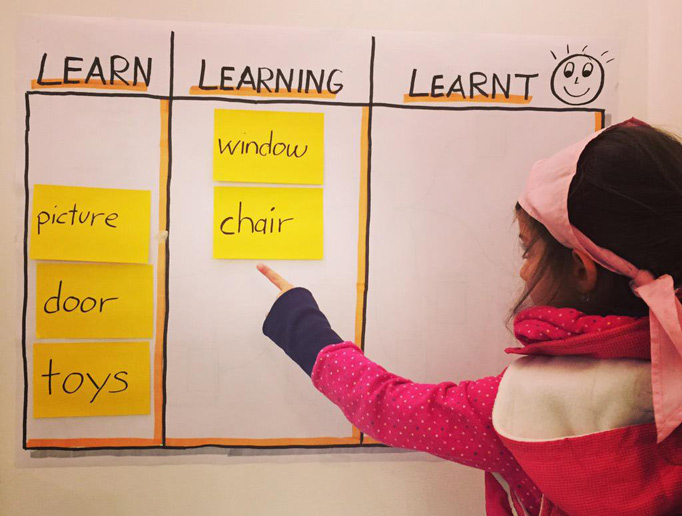
Agile Learning with Kids
I encouraged her to take ownership on her new board so that she can progress without any further assistance. That’s why I chose to introduce her a helpful tool instead of teaching her english on a classical way. She was excited about the Kanban Board and asked me right away to fill up the “learn”-column.
Keeping relation to reality
Now comes on of the most important details I discovered within this gamified method: I only filled up the learning column with words and phrases that fit into her life’s context.
As I knew that she loved “Mickey Mouse” for a period of time, I picked words that were close to this topic. The idea was to maintain a vocabulary that is useful for her current situation. The result was that she started practicing with me and the family talking about her favorite TV Show in english. This fact increased her motivation clearly and she was always keen on learning more and more. However, this requires a good observation of the mentor’s role as the life’s context of a kid can change rapidly: Inspect & Adapt constantly :-)
Every morning before I left to work, we made a small stand-up and I asked her for the vocabulary in the “learning” column. This worked out surprisingly well as she understood it as a game without having fear to fail. She jumped around and laughed which was a clear sign for me that this experiment worked great for her. She was just excited when she moved an item from the middle column to the right “learned” – column.
The girl was proud of her own progress and asked me every 3 days to fill up more words. So I did. After 2 weeks her vocabulary increased:
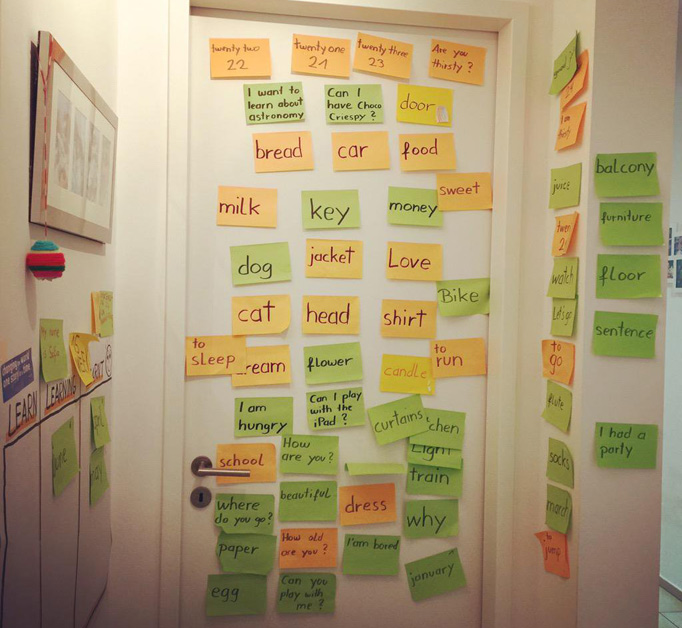
Agile Learning Result after 2 Weeks
Mentor, stimulate, provoke and engage
I think one of the reasons why she progressed so fast was the fact that she was not forced to do it. From the beginning it was her idea: learning a foreign language. So she had a clear goal in mind and this motivated her to continue. Instead of being a Teacher, I tried to engage her as a mentor with some tips on how to remember the words on a funny and playful way. Here you can see that she came up with the idea to paint the object next to the word so she can remember it better:
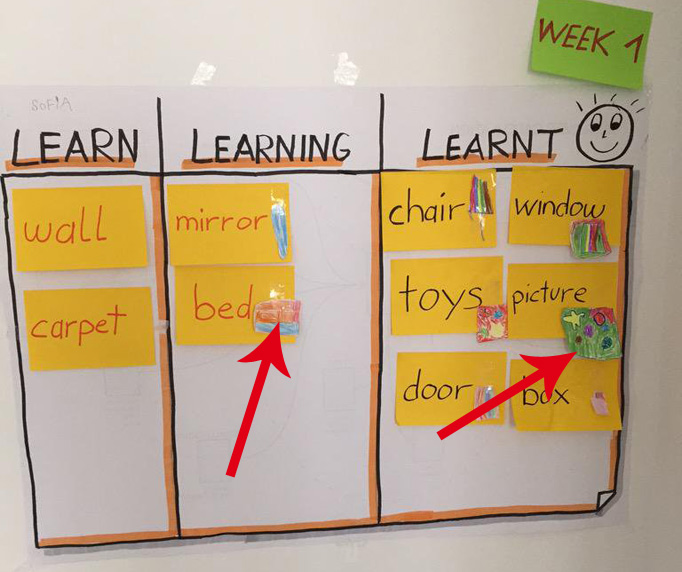 In every day life my wife and I provoked her a bit with english questions that she could answer with the words she already learned. However, with the time she discovered some moments of frustration and I asked her for some actions she could take in order to solve it. One action she took was to pick only one item instead of two into the middle (learning) column:
In every day life my wife and I provoked her a bit with english questions that she could answer with the words she already learned. However, with the time she discovered some moments of frustration and I asked her for some actions she could take in order to solve it. One action she took was to pick only one item instead of two into the middle (learning) column:
“If I focus only on one word at a time, I can learn it better”.
In a professional Agile Environment we call this the “Work in Progress Limit” (WIP). Focusing on one item at a time seems to be something natural. She changed the rules of the tool to her needs and this was exactly what I wanted to achieve.
After about 4 weeks she was able to talk some simple sentences in english. I was incredibly happy to see her progressing. She took 100% ownership on her board and adjusted it with the time.
She understood the advantage of the tool so she started to adapt it. Here is an example of a visual board that she uses to plan her day:
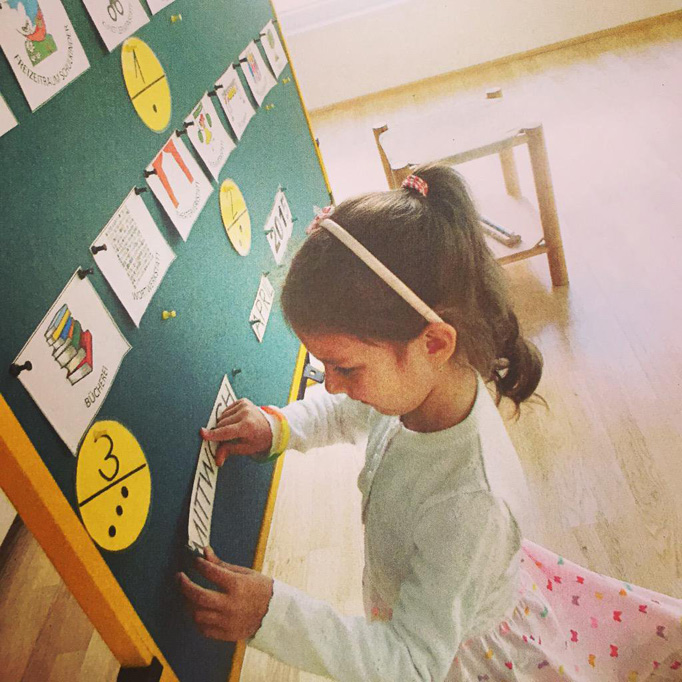
This very easy technique gives equal weight to arts, self-confidence and independence. Instead of following routine algorithms that we get taught in school, we should encourage our children to excite the power of imagination and curiosity.
Agile learning works!
With this article I want to engage my readers to follow this learning experiment. Feel free to try it out and let me know how it worked out. Share your experience with us and tell the community in the comments on how your kids received the idea of learning iteratively.
As I wrote in the beginning of this article, this model can be adapted for young kids, teenagers and even adults. Just run the experiment like I did and measure your success. You might fail, but the chances to succeed are much higher.
You liked the article? I love Feedback! I would appreciate a comment or a star rating:

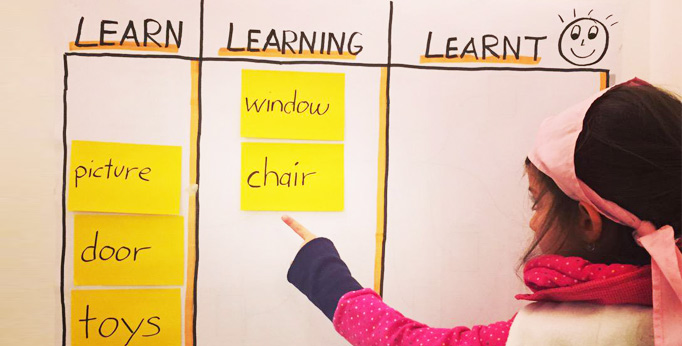

Hi Dominic!
Very inspirational story!
Just two points:
(1) A bit problematic could be the Wort = object = word-equations. Languages don´t work this way. And, normally, I wouldn´t encourage such an obsolete learning style. But, I´ve never taught very little kids (only kids > 12 years and adults) foreign languages. So, in this case, it might work… :-)
(2) Listening and speaking
In order to speak a language, listening is crucial. Learning written words / reading is rather useful for developing “writing” skills.
So, it makes more sense to use short dialogs (everyday communications, listening to stories for children, etc.) than to memorize written words on a Kanban board if the goal is to improve the “oral” skills of your daughter.
But, many roads lead to Rome… and the most important thing is probably that your daughter was motivated and happy during the whole learning experience.